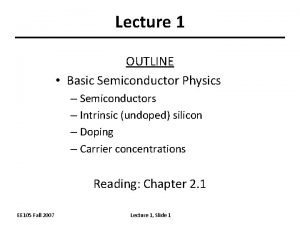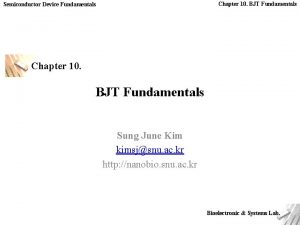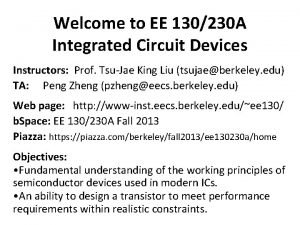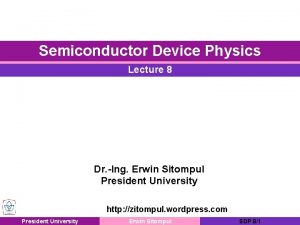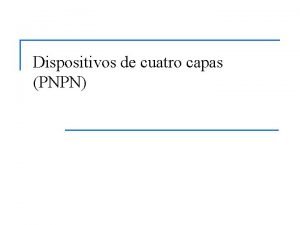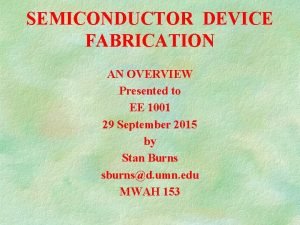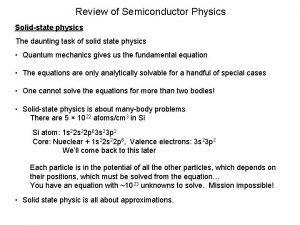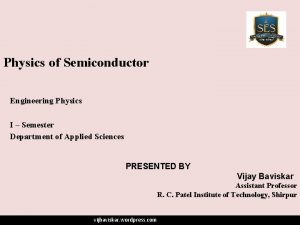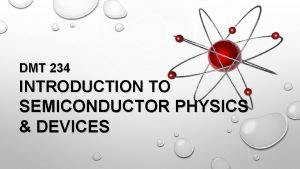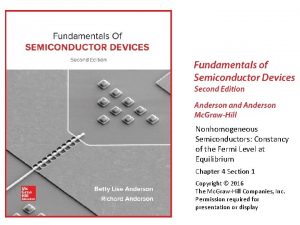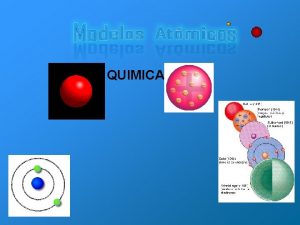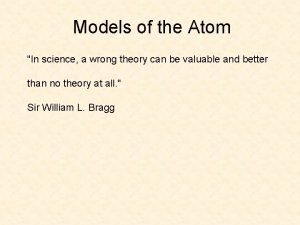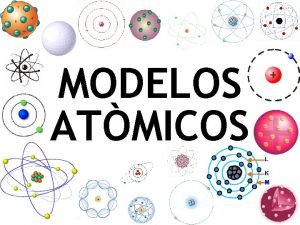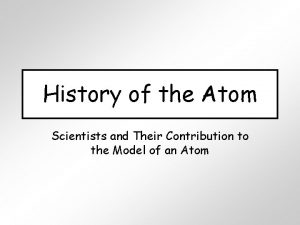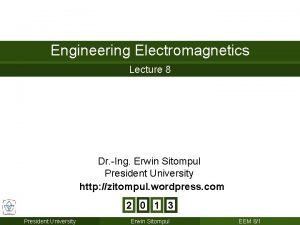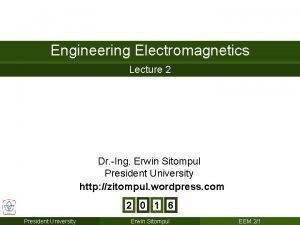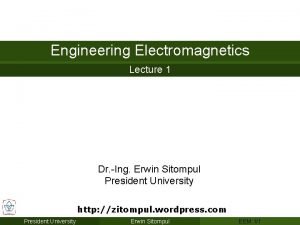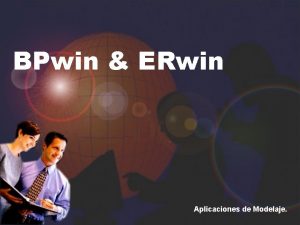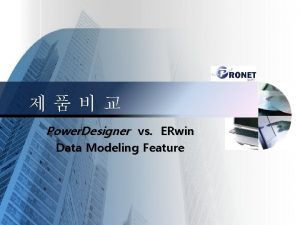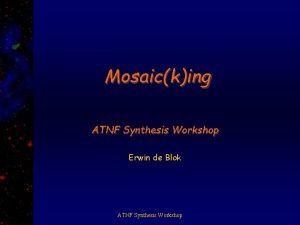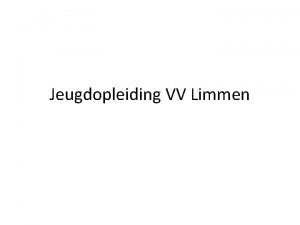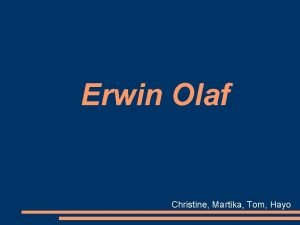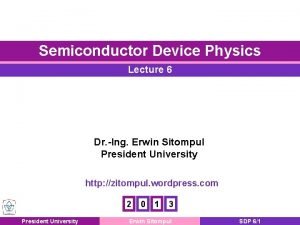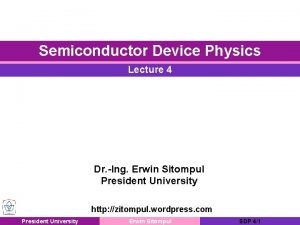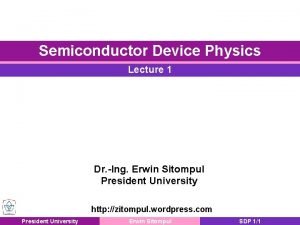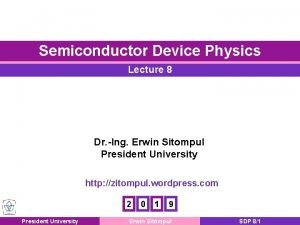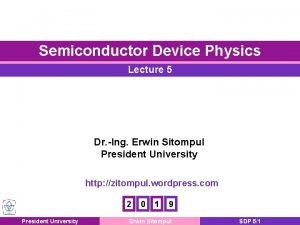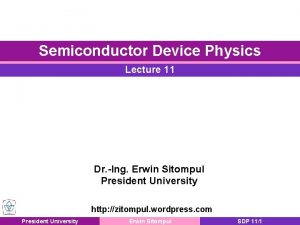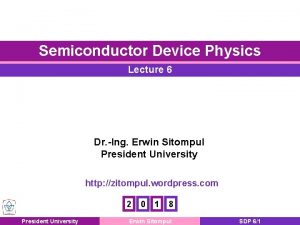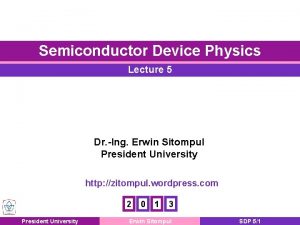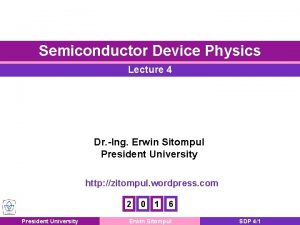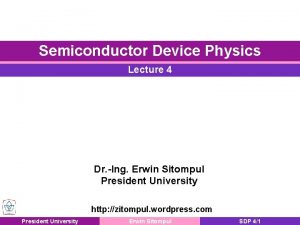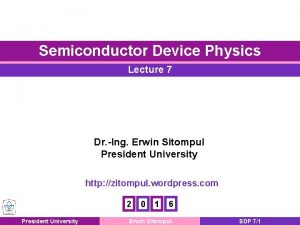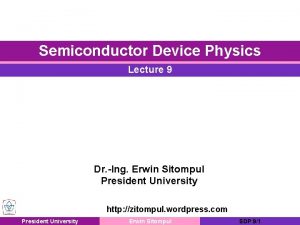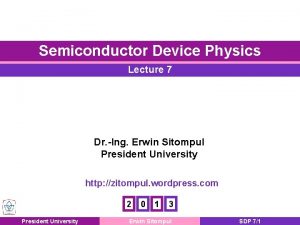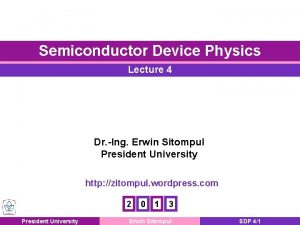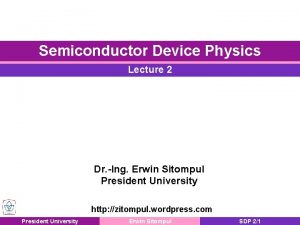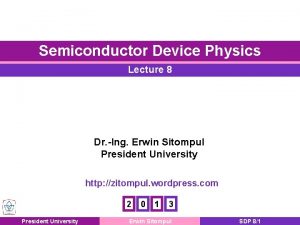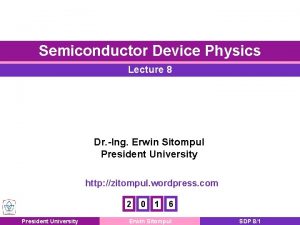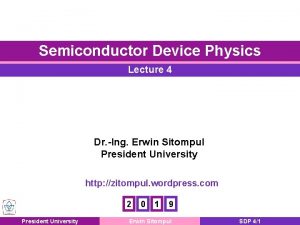Semiconductor Device Physics Lecture 1 Dr Ing Erwin




































- Slides: 36

Semiconductor Device Physics Lecture 1 Dr. -Ing. Erwin Sitompul President University http: //zitompul. wordpress. com 2 President University 0 1 3 Erwin Sitompul SDP 1/1

Semiconductor Device Physics Textbook and Syllabus Textbook: “Semiconductor Device Fundamentals”, Robert F. Pierret, International Edition, Addison Wesley, 1996. Syllabus: Chapter 1: Semiconductors: A General Introduction Chapter 2: Carrier Modeling Chapter 3: Carrier Action Chapter 5: pn Junction Electrostatics Chapter 6: pn Junction Diode: I–V Characteristics Chapter 7: pn Junction Diode: Small-Signal Admittance Chapter 8: pn Junction Diode: Transient Response Chapter 14: MS Contacts and Schottky Diodes Chapter 9: Optoelectronic Diodes Chapter 10: BJT Fundamentals Chapter 11: BJT Static Characteristics Chapter 12: BJT Dynamic Response Modeling President University Erwin Sitompul SDP 1/2

Semiconductor Device Physics Grade Policy Final Grade = 10% Homework + 20% Quizzes + 30% Midterm Exam + 40% Final Exam + Extra Points § Homeworks will be given in fairly regular basis. The average of homework grades contributes 10% of final grade. § Homeworks are to be written on A 4 papers, otherwise they will not be graded. § Homeworks must be submitted on time, one day before the schedule of the lecture. Late submission will be penalized by point deduction of – 10·n, where n is the total number of lateness made. § There will be 3 quizzes. Only the best 2 will be counted. The average of quiz grades contributes 20% of final grade. § The maximum lateness in coming to class is 25 minutes, otherwise attendance will not be counted. President University Erwin Sitompul SDP 1/3

Semiconductor Device Physics Grade Policy Semiconductor Device Physics Homework 2 Ito Chen 009201700008 21 March 2021 D 6. 2. Answer: . . . . • Heading of Homework Papers (Required) § Midterm and final exams follow the schedule released by AAB (Academic Administration Bureau). § Make up of quizzes must be held within one week after the schedule of the respective quiz. § Make up for mid exam and final exam must be requested directly to AAB. President University Erwin Sitompul SDP 1/4

Semiconductor Device Physics Grade Policy § In order to maintain the integrity, the score of a make up quiz or exam can be multiplied by 0. 9 (i. e. , the maximum score for a make up will be 90). § Extra points will be given every time you solve a problem in front of the class or answer a question. You will earn 1 or 2 points. § Lecture slides can be copied during class session. The updated version will be available on the lecture homepage around 1 day after class schedule. Please check regularly. http: //zitompul. wordpress. com § The use of internet for any purpose during class sessions is strictly forbidden. § You are expected to write a note along the lectures to record your own conclusions or materials which are not covered by the lecture slides. President University Erwin Sitompul SDP 1/5

Semiconductor Device Physics Greek Alphabet —new —zz-eye —pie —taw —fie —k-eye —sigh —mew President University Erwin Sitompul SDP 1/6

Semiconductor Device Physics Chapter 1 Semiconductors: A General Introduction President University Erwin Sitompul SDP 1/7

Chapter 1 Semiconductors: A General Introduction What is a Semiconductor? n Low resistivity “conductor” n High resistivity “insulator” n Intermediate resistivity “semiconductor” n The conductivity (and at the same time the resistivity) of semiconductors lie between that of conductors and insulators. President University Erwin Sitompul SDP 1/8

Chapter 1 Semiconductors: A General Introduction What is a Semiconductor? n Semiconductors are some of the purest solid materials in existence, because any trace of impurity atoms called “dopants” can change the electrical properties of semiconductors drastically. n Unintentional impurity level: 1 impurity atom per 109 semiconductor atom. n Intentional impurity ranging from 1 per 108 to 1 per 103. No recognizable long-range order Entire solid is made up of atoms in an orderly three- dimensional array Completely ordered in segments polycrystalline amorphous crystalline n Most devices fabricated today employ crystalline semiconductors. President University Erwin Sitompul SDP 1/9

Chapter 1 Semiconductors: A General Introduction Semiconductor Materials Elemental: Si, Ge, C Compound: IV-IV III-VI Alloy: Si 1 -x. Gex Alx. Ga 1 -x. As As Cd Se Ga Si. C Ga. As, Ga. N Cd. Se : Arsenic : Cadmium : Selenium : Gallium President University Erwin Sitompul SDP 1/10

Chapter 1 Semiconductors: A General Introduction From Hydrogen to Silicon President University Erwin Sitompul SDP 1/11

Chapter 1 Semiconductors: A General Introduction The Silicon Atom n 14 electrons occupying the first 3 energy levels: n 1 s, 2 p orbitals are filled by 10 electrons. n 3 s, 3 p orbitals filled by 4 electrons. n To minimize the overall energy, the 3 s and 3 p orbitals hybridize to form four tetrahedral 3 sp orbital. n Each has one electron and is capable of forming a bond with a neighboring atom. President University Erwin Sitompul SDP 1/12

Chapter 1 Semiconductors: A General Introduction The Si Crystal • Each Si atom has 4 nearest • neighbors. Atom lattice constant (length of the unit cell side) ° 1 A=10 ° – 10 m a = 5. 431 A, • Each cell contains: 8 corner atoms 6 face atoms 4 interior atoms a “Diamond Lattice” President University Erwin Sitompul SDP 1/13

Chapter 1 Semiconductors: A General Introduction How Many Silicon Atoms per cm– 3? n Number of atoms in a unit cell: n 4 atoms completely inside cell n Each of the 8 atoms on corners are shared among 8 cells count as 1 atom inside cell n Each of the 6 atoms on the faces are shared among 2 cells count as 3 atoms inside cell Total number inside the cell = 4 + 1 + 3 = 8 n Cell volume = (. 543 nm)3 = 1. 6 x 10– 22 cm 3 n Density of silicon atom = (8 atoms) / (cell volume) = 5 × 1022 atoms/cm 3 • What is density of silicon in g/cm 3? President University Erwin Sitompul SDP 1/14

Chapter 1 Semiconductors: A General Introduction Compound Semiconductors n “Zincblende” structure n III-V compound semiconductors: Ga. As, Ga. P, Ga. N, etc. President University Erwin Sitompul SDP 1/15

Chapter 1 Semiconductors: A General Introduction Crystallographic Notation Miller Indices Notation Interpretation (hkl) crystal plane {hkl} equivalent planes [hkl] crystal direction <hkl> equivalent directions h: inverse x-intercept of plane k: inverse y-intercept of plane l: inverse z-intercept of plane (h, k and l are reduced to 3 integers having the same ratio. ) President University Erwin Sitompul SDP 1/16

Chapter 1 Semiconductors: A General Introduction Crystallographic Planes (632) plane President University (001) plane Erwin Sitompul _ (221) plane SDP 1/17

Chapter 1 Semiconductors: A General Introduction Crystallographic Planes President University Erwin Sitompul SDP 1/18

Chapter 1 Semiconductors: A General Introduction Crystallographic Planes of Si Wafers n Silicon wafers are usually cut along a {100} plane with a flat or notch to orient the wafer during integrated-circuit fabrication. n The facing surface is polished and etched yielding mirror-like finish. President University Erwin Sitompul SDP 1/19

Chapter 1 Semiconductors: A General Introduction Crystal Growth Until Device Fabrication President University Erwin Sitompul SDP 1/20

Chapter 1 Semiconductors: A General Introduction Crystallographic Planes of Si Unit cell: View in <111> direction View in <100> direction President University View in <110> direction Erwin Sitompul SDP 1/21

Chapter 2 Carrier Modeling President University Erwin Sitompul SDP 1/22

Chapter 2 Carrier Modeling Electronic Properties of Si n Silicon is a semiconductor material. n Pure Si has a relatively high electrical resistivity at room temperature. n There are 2 types of mobile charge-carriers in Si: n Conduction electrons are negatively charged, e = – 1. 602 10– 19 C n Holes are positively charged, p = +1. 602 10– 19 C n The concentration (number of atom/cm 3) of conduction electrons & holes in a semiconductor can be influenced in several ways: n Adding special impurity atoms (dopants) n Applying an electric field n Changing the temperature n Irradiation President University Erwin Sitompul SDP 1/23

Chapter 2 Carrier Modeling Bond Model of Electrons and Holes n 2 -D Representation Hole n When an electron breaks loose and becomes a conduction electron, then a hole is created. Si Si President University Erwin Sitompul Si Si Conduction electron SDP 1/24

Chapter 2 Carrier Modeling What is a Hole? n A hole is a positive charge associated with a half-filled covalent bond. n A hole is treated as a positively charged mobile particle in the semiconductor. President University Erwin Sitompul SDP 1/25

Chapter 2 Carrier Modeling Conduction Electron and Hole of Pure Si • Covalent (shared e–) bonds exists • between Si atoms in a crystal. Since the e– are loosely bound, some will be free at any T, creating hole-electron pairs. ni = intrinsic carrier concentration President University ni ≈ 1010 cm– 3 at room temperature Erwin Sitompul SDP 1/26

Chapter 2 Carrier Modeling Si: From Atom to Crystal Energy states (in Si atom) Energy bands (in Si crystal) • The highest mostly-filled • President University band is the valence band. The lowest mostly-empty band is the conduction band. Erwin Sitompul SDP 1/27

Chapter 2 Carrier Modeling Energy Band Diagram Electron energy Ec EG, band gap energy Ev • For Silicon at 300 K, EG = 1. 12 e. V • 1 e. V = 1. 6 x 10– 19 J n Simplified version of energy band model, indicating: n Lowest possible conduction band energy (Ec) n Highest possible valence band energy (Ev) n Ec and Ev are separated by the band gap energy EG. President University Erwin Sitompul SDP 1/28

Chapter 2 Carrier Modeling Measuring Band Gap Energy n EG can be determined from the minimum energy (hn) of photons that can be absorbed by the semiconductor. n This amount of energy equals the energy required to move a single electron from valence band to conduction band. Electron Ec Photon photon energy: hn = EG Ev Hole Band gap energies President University Erwin Sitompul SDP 1/29

Chapter 2 Carrier Modeling Carriers n Completely filled or empty bands do not allow current flow, because no carriers available. n Broken covalent bonds produce carriers (electrons and holes) and make current flow possible. n The excited electron moves from valence band to conduction band. n Conduction band is not completely empty anymore. n Valence band is not completely filled anymore. President University Erwin Sitompul SDP 1/30

Chapter 2 Carrier Modeling Band Gap and Material Classification Ec Ev Ec EG= ~8 e. V Ev Si. O 2 EG = 1. 12 e. V Si Ec Ec Ev Ev Metal n Insulators have large band gap EG. n Semiconductors have relatively small band gap EG. n Metals have very narrow band gap EG. n Even, in some cases conduction band is partially filled, Ev > Ec. President University Erwin Sitompul SDP 1/31

Chapter 2 Carrier Modeling Carrier Numbers in Intrinsic Material n More new notations are presented now: n n : number of electrons/cm 3 n p : number of holes/cm 3 n ni : intrinsic carrier concentration n In a pure semiconductor, n = p = ni. n At room temperature, ni = 2 106 /cm 3 in Ga. As ni = 1 1010 /cm 3 in Si ni = 2 1013 /cm 3 in Ge President University Erwin Sitompul SDP 1/32

Semiconductor Device Physics Semester Schedule FCS 1 SDP 1 FCS 2 SDP 2 Rec 1 President University Erwin Sitompul SDP 1/33

Semiconductor Device Physics Semester Schedule SDP 3 FCS 5 SDP 5 FCS 6 SDP 4 FCS 4 Rec 2 Rec 3 Rec 4 SDP 6 Rec 5 Mid President University Mid Erwin Sitompul Mid SDP 1/34

Semiconductor Device Physics Semester Schedule Mid FCS 7 FCS 8 SDP 7 FCS 9 ? SDP 9 FCS 10 Rec 5 SDP 8 Rec 6 Rec 7 Rec 8 President University Erwin Sitompul SDP 1/35

Semiconductor Device Physics Semester Schedule SDP 10 FCS 11 FCS 12 SDP 11 Rec 9 Rec 10 Final President University Final Erwin Sitompul Final SDP 1/36
 Cpu output device
Cpu output device Semiconductor lecture
Semiconductor lecture Power semiconductor devices lecture notes
Power semiconductor devices lecture notes Zerobioelectronic
Zerobioelectronic Ee 130
Ee 130 Semiconductor device fundamentals
Semiconductor device fundamentals Dispositivos de 4 capas
Dispositivos de 4 capas Semiconductor device fabrication
Semiconductor device fabrication What does a semiconductor look like
What does a semiconductor look like Wigner seitz cell of fcc
Wigner seitz cell of fcc Semiconductor engineering physics
Semiconductor engineering physics Introduction to semiconductor physics
Introduction to semiconductor physics 2 types of semiconductor
2 types of semiconductor 01:640:244 lecture notes - lecture 15: plat, idah, farad
01:640:244 lecture notes - lecture 15: plat, idah, farad Classical mechanics
Classical mechanics What is a harmonic wave in physics
What is a harmonic wave in physics Physics 101 lecture 1
Physics 101 lecture 1 Physics 101 lecture notes pdf
Physics 101 lecture notes pdf Wave notes
Wave notes Atmospheric physics lecture notes
Atmospheric physics lecture notes Art as a humanistic discipline explanation
Art as a humanistic discipline explanation Modelo de dalton mg
Modelo de dalton mg Erwin schrödinger atomic theory
Erwin schrödinger atomic theory Atomo de niels bohr
Atomo de niels bohr Schrodinger atomic theory
Schrodinger atomic theory Erwin moeyaert
Erwin moeyaert Erwin sitompul
Erwin sitompul Erwin sitompul
Erwin sitompul Dot ing
Dot ing Bpwin
Bpwin Schrodinger atomic theory
Schrodinger atomic theory Erwin vs
Erwin vs Erwin de blok
Erwin de blok Erwin chargaff definition biology
Erwin chargaff definition biology Erwin tump
Erwin tump Regla de erwin chargaff 1940
Regla de erwin chargaff 1940 Erwin olaf biografie
Erwin olaf biografie

